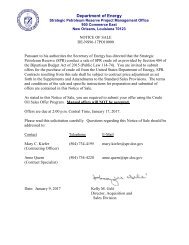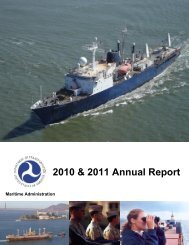Create successful ePaper yourself
Turn your PDF publications into a flip-book with our unique Google optimized e-Paper software.
THE U.S. MARINE CORPS<br />
The Marine Corps remains America’s expeditionary<br />
force in readiness. This amphibious<br />
expeditionary role reflects the intent of the<br />
82nd Congress in the early 1950s when it<br />
directed, “The nation’s shock troops must be<br />
the most ready when the nation is least ready<br />
… to provide a balanced force in readiness for<br />
a naval campaign and, at the same time, a<br />
ground and air striking force ready to suppress<br />
or contain international disturbances short of<br />
large-scale war.” This prescient guidance on<br />
a daily basis shapes the culture, organization,<br />
training, equipment and priorities of<br />
the Marine Corps and the Navy-Marine Corps<br />
team. Everything the Marine Corps undertakes<br />
must tangibly and visibly contribute to its<br />
combat readiness and effectiveness.<br />
Operating from expeditionary forward locations, amphibious<br />
warships and alternative sea-based platforms,<br />
Marines remain forward deployed around the world,<br />
protecting not only our nation, but also supporting the<br />
international order that underpins our prosperity and<br />
security. In a world of brushfire instabilities, violent<br />
extremism, nonstate threats and struggling sovereign<br />
entities, Marines are needed to respond to unfolding crises<br />
and support and defend U.S. interests.<br />
The Marine Air-Ground Task Force (MAGTF) is a unique,<br />
scalable and flexible warfighting organization that<br />
combines the presence and power-projection capabilities<br />
of the entire naval force and leverages and applies<br />
the power and capabilities of joint, allied and coalition<br />
forces. In any crisis, contingency or major war, the<br />
operational and combat synergy of the MAGTF and the<br />
joint or allied expeditionary force is far more powerful<br />
and effective than the simple sum of its unit elements.<br />
Powerful maritime force combinations leverage their<br />
control of the seas and littorals to influence the affairs of<br />
populations ashore.<br />
The Navy-Marine Corps amphibious team lives on the<br />
seams, bringing air, sea and ground capabilities together<br />
into one tightly knit tactical package. Marine forces are<br />
designed for rapid crisis response, partnership building<br />
and smaller-scale expeditionary interventions, but also<br />
can scale up to larger forcible-entry operations from the<br />
sea as the situation demands. Routinely, Marines operate<br />
from austere expeditionary locations without the need<br />
for a large footprint ashore, but with the ability to swiftly<br />
move from one potential crisis area to another and back<br />
to sea when temporary interventions ashore are complete.<br />
They leverage their proximity to sources of conflict<br />
to respond within hours or days, rather than weeks. The<br />
MAGTF provides integrated cross-domain capabilities,<br />
leveraging the sea as maneuver space, and the ability to<br />
operate air and ground capabilities forward as a strategic<br />
hedge against unpredicted crises. It is a microcosm of the<br />
joint force, useful as an independent-maneuver element<br />
for joint commanders, or as an early entry capability for<br />
the larger joint force.<br />
With integrated strike and long-range maneuver by air<br />
or surface, the Navy-Marine Corps team acts as a first<br />
responder for the joint force across a wide range of<br />
scenarios. Control of the seas and littorals remains a fundamental<br />
objective and pillar of strength for our mari time<br />
nation and forces. The ethos and principles define the<br />
identity of the Marine Corps and connect all Marines<br />
— past, present and future — with who they are and<br />
with what they do on behalf of the American people and<br />
nation. The Marine Corps is light enough to move swiftly<br />
to the source of trouble, but heavy enough to prevail<br />
against most threats. Marines will maintain ready forces<br />
today to answer the call, fight and win. The flexibility and<br />
strategic mobility of the MAGTF make it ideal for creating<br />
and exploiting access in uncertain or denied areas.<br />
Modern amphibious concepts seek to achieve their broad<br />
range of effects through dispersed-maneuver elements,<br />
integrated fires and expeditionary logistics rather than<br />
massed assault.<br />
As the MV-22 Osprey tiltrotor aircraft completes fielding,<br />
the game-changing nature of the aircraft already<br />
has expanded MAGTF capabilities during both combat<br />
and crisis-response operations. The capability of the<br />
fifth-generation short-takeoff/vertical-landing F-35Bs<br />
operating from amphibious flight decks or dispersed<br />
expeditionary airfields will increase the organic capabilities<br />
of the MAGTF and provide more options and greater<br />
flexibility for joint planners and commanders. These two<br />
unique Marine Corps platforms are informing and shaping<br />
MAGTF combat development and will result in a far more<br />
combat-ready and capable Marine Corps in the future.<br />
Additionally, the Marine Corps’ response capabilities are<br />
enhanced by two specialized Maritime Prepositioning<br />
Ship squadrons. Originally designed for pier-side or nearshore<br />
in-stream offload, this family of Military Sealift<br />
2017-2018 <strong>MARITIME</strong> POLICY 13




